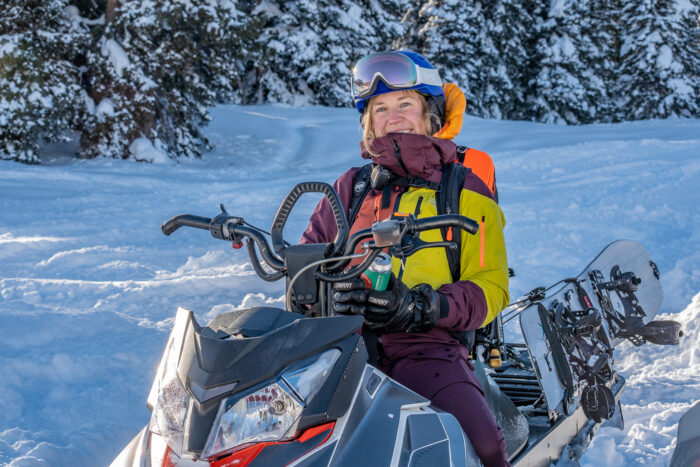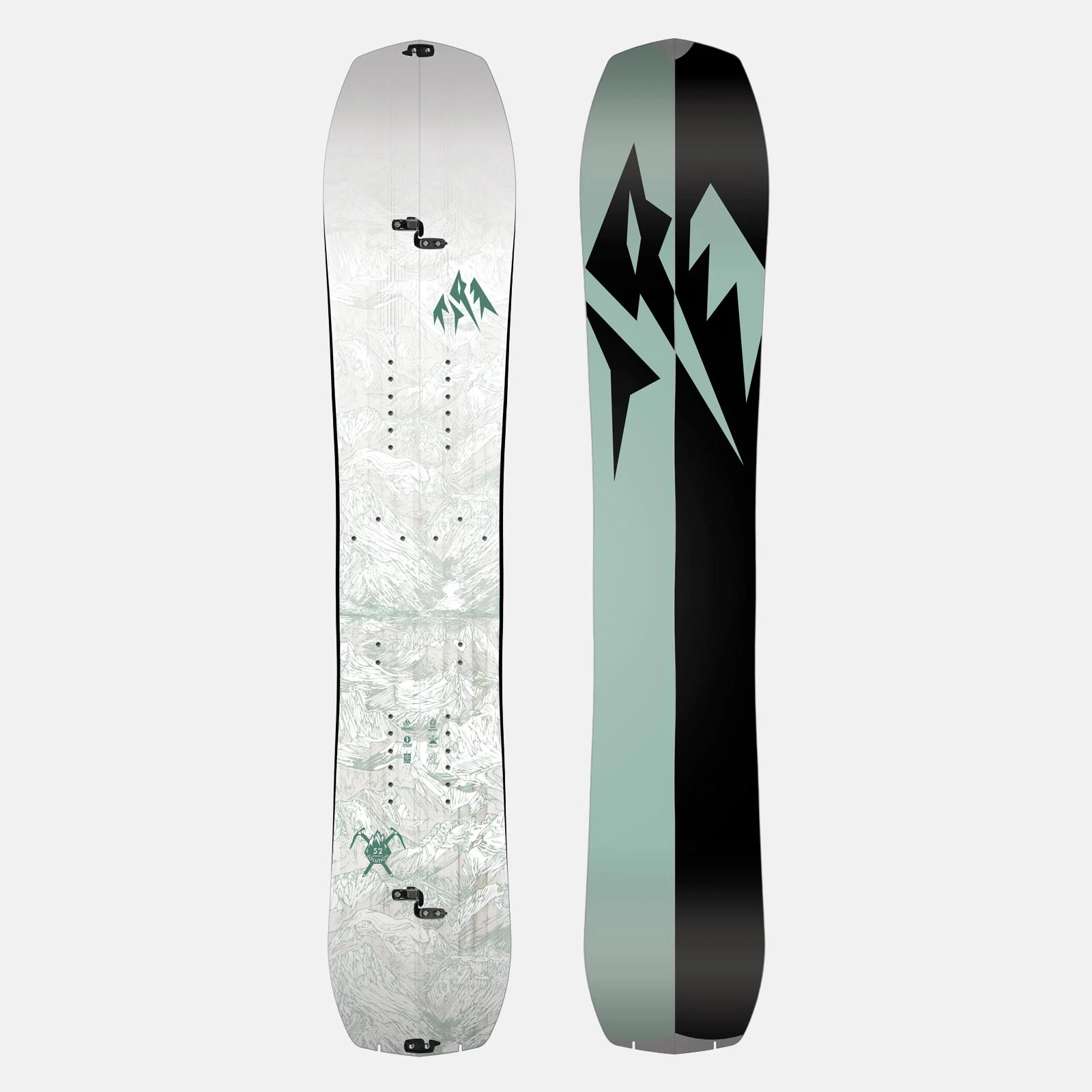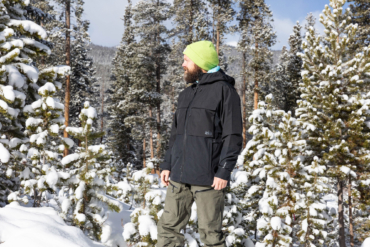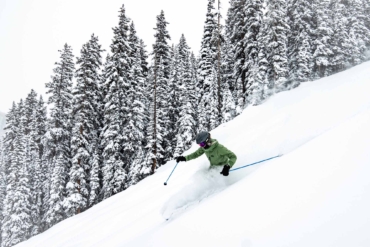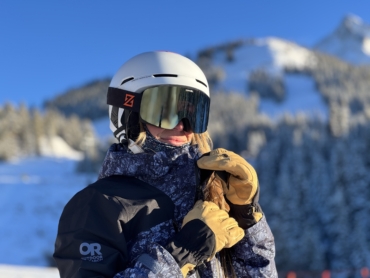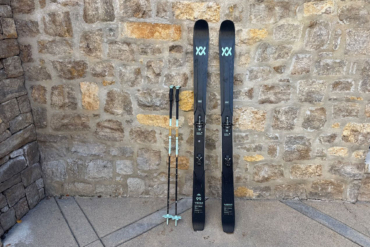I’ve been a fan of the all-terrain Jones Women’s Solution Splitboard for many winters. But the technology loaded into the current iteration takes this women’s-specific design to a fresh level of muscle with a dash of play.
In parallel, Jones Snowboards consistently pushes the envelope for sustainable manufacturing and transparency, which we stand behind. The ladies’ Solution is a stout women’s-specific design that handles a bell-to-bell backcountry season across all types of terrain, variable snow, gripping moments, pow surf, and big days. The sticks feel as dependable on the uphill as the ride is on the down.
This splitboard is loaded with the brand’s most progressive design features, including a 3D Contour Base, Traction Tech 3.0, Karakoram Tip-Lock clips, and Karakoram Ultra Clips 2.0. In other words, the board’s construction and dimensions is tailored to gals, yet none of the top-shelf materials are left out.
Whether the mission is to weave tight lines through the aspens and evergreens, paint newly canvased slopes, gas down an open face, traverse an iron slab, or drop into a 45-degree chute, the women’s Solution continues to be staunch, trusty, and tenacious.
In short: The Jones Women’s Solution ($980) is a premium choice for experienced, dedicated splitboarders looking to invest in a big-mountain tool that will handle difficult terrain and snow conditions, climb after climb, and that’s also good to gallop down pow fields.
Read The Best Splitboards for Men and Women buyer’s guide.
- Price: $980
- Setback: 2 cm
- Taper: 12.5 mm (size 152)
- Flex: 7
- Sizes: 146, 149, 152, 155
- Shape: Directional
- Profile: Directional rocker in the nose, camber underfoot, rockered tail
Pros
- All-mountain aggressive ripper
- Flirty spoon nose
- Recycled interior and exterior edges and ABS sidewalls
- Tenacious, enduring construction that lasts season after season
Cons
- Edges ice at an 8/10 level, so remain vigilant on stiff, steep entrances
- Stiffer, but not the rigidest option on our list
- Premium investment
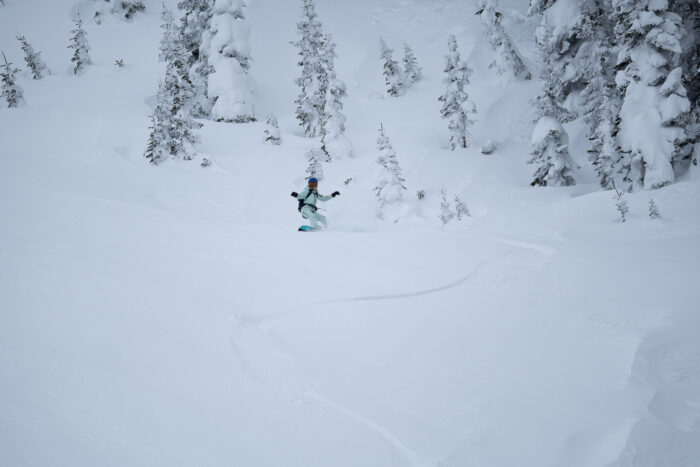
Jones Women’s Solution Review
Back in 2017, I bought the 2016 model of the Jones Women’s Solution splitboard, a design that originally launched with the men’s model in 2011. The women’s specific version debuted two seasons later in 2013.
While I’ve only been on this revamped version of the women’s Solution for one season, I was blown away by how durable the original version of this splitboard is, a testament to how well Jones makes its boards. In all those seasons of root-snarled early winter or late spring approaches, only one serious core gash marked the base. Otherwise, the metal edges, sidewalls, topsheet, and power in the splitty all held up.
If you’re on the fence about the price, rest assured, you’ll be able to keep this splitboard for many seasons if she gets basic seasonal maintenance, you don’t fall a human’s length onto a shark, and the ride is properly stored.
Touring with the current Jones Women’s Solution, I rode the splitboard throughout Colorado’s Elk Mountains. The snow conditions of approaches and descents ranged from variable, hardpack, sugar, and sastrugi to extensive, harmonious lines of pow-pow and steep, hair-raising chutes.
Compared to the older model, the new-age changes included the 3D Contour Base, as well as the interior and exterior Traction Tech 3.0, Karakoram Tip-Lock clips, Karakoram Ultra Clips 2.0, and an increase in sustainable materials. I dive into the details below.
Overall, I liked both the old model and the new. Here’s the breakdown.



Directional Profile and Shape
All around, this splitboard is directional, helping to carry energy forward. That includes the shape and profile, which has a near middle-of-the-road-to-stiffer flex throughout. I found it was a 7 out of 10.
I’ve found this directional shape to be a great fit for whatever the objective entails. That goes for all types of snow conditions, too. The tail has a minimal taper of 12.5 mm, meaning the nose is slightly wider and the tail is a bit narrower. This isn’t an aggressive taper — just enough — and riding switch is still comfortable.
A taper allows the backend to sink a tad easier in snow and pop the head above the surface. Turn initiation on a solid face is a little easier, too. The sidecut gradually increases toward the contact points of the edge, so it doesn’t feel grabby. Transitions are super smooth, for which we can also thank the detuned tip and tail edges.
The core is made with high-quality paulownia and minimal poplar stringers for power and longevity.
The profile is also directional, with a progressive hybrid rocker-camber pattern. Camber is located between and beneath the feet. A mild rocker starts at the back binding and moves into the tail.
More pronounced rocker is placed ahead of the front binding, toward the tip of the splitboard. Paired with the blunt nose and the contoured base, which I dive into below, the nose rides well above deep powder and crust alike.
This build is moderately stiff, though not as rigid as the Stranda Women’s Descender Splitboard. The Solution is more directional and stiffer than the Jones Dream Weaver, which offers a slightly more balanced feel underfoot with a greater sidecut.
In contrast, the Dream Weaver’s construction is softer and feels more playful, making the board easy to thread through tight glades and a fair trooper in deep snow or shaking like the Macarena over suncups — the board doesn’t push back. But, I also found the Dream Weaver can be too noodled and wash out when high alpine conditions are firm, so if you’re trying to ride more aggressively, go for the Solution.
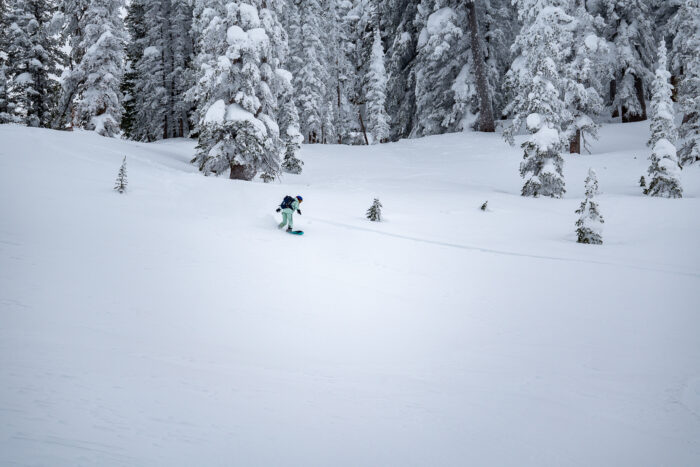
Spooned and Blunt Nose
The spooned nose is clutch. Inspired by surfboards, Jones Snowboards Founder Jeremy Jones imagined that splitboards could benefit from a subtle curve along the base: imagine the bowl of a spoon concentrated at the tip and tail of the board. The nose and backside of the splitboard curves in all directions like a scraped-out half-grapefruit, versus the medial nose-to-tail upturn of a banana profile, with a 7mm bevel that starts at the rocker.
Called the 3D Contour Base, which first launched in select splitboards in 2021, the design makes transitioning into turns more nimble with less resistance and an increased glide. I found that to be spot on — and shredding with a spooned nose is one helluva good time. Goodbye, punchy nose dives. Hello, freedom.
While the nose is fun for speed-gliding down powder, the 3D Contour Base also kept me above dusted surface crust while enjoying spring lines — which was equally a blast!
As for the blunt silhouette of the nose, that also helps alleviate friction of plowing through deep cotton-like snow without deterring the float, because it nixes a bit of weight and drag.
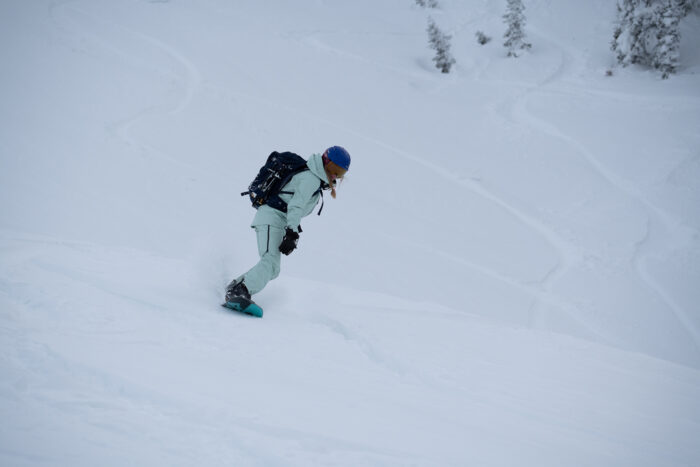
Traction Tech 3.0: Grip on Ice
I really dig the Traction Tech 3.0, which adds a slightly wavy silhouette to the interior and exterior edges of the splitboard. The “3.0” level means there are three exaggerations or bumps along the edge — with the center bump more in the sidecut and larger than the other two bumps — increasing the contact points for snow. That extra nip is available on all sides of the splitboard or split skis, so it’s effective while climbing or descending.
Traction Tech comes in three variations: 1.0, 2.0, or 3.0. Each style features three undulations. The difference is the size of the bumps. Traction 1.0 has three bumps that are milder than 2.0 and 3.0, but reach the same distance. Traction 2.0 is more moderate in size, and all three bumps are equal in size. Traction 3.0 has the most aggressive bumps, and the central bump sticks out farther than the other two.
More bumps, more grip. The grippiest option is the best pick for icy conditions, and I can attest to that.
This design is tailored, but the concept isn’t totally new. Mervin Manufacturing has had magne-traction in its snowboards since at least 2002, when Danny Kass won an Olympic Silver Medal on a GNU snowboard with magne-traction, which is like a serrated edge that grips the snow with extra teeth. Jones introduced the initial technology to the brand’s boards in 2011, under the name Mellow Magne Traction, and updated the name in 2017. Over the years, the three iterations of Traction Tech were added.
Though, of Mervin’s brands, Roxy doesn’t currently have any splitboards. Lib Tech’s Split BRD is unisex and has magne-traction. GNU has a women’s-specific Barrett Split with a new iteration of magne-traction called the progressive pro magne-traction technology. We’ll keep you posted on how testing goes!
Locking Tail Clips
Nerve-wracking and meditation-jolting are two hyphenated words for dropping into a line and seeing the tip clip pop open.
To date, this is the only women’s splitboard I’ve tested with the ultra-secure Karakoram Tip-Lock tail clips, and I can see the appeal. The design has a streamlined lock that swivels nearly 180 degrees to close off the clip for additional insurance.
That extra micro-step when pulling the board apart into split skis or putting them back together took getting used to but overall, I appreciated the safety checkpoint.
The Karakoram Ultra Clips 2.0, of which there are two sets that reconnect and hold shut the interior edges of the splitboard, are smaller and lightweight compared to the original Ultra clip design.



Sustainability
Jones is now home to the world’s first-ever snowboard recycling program. The brand takes any snowboard and reuses the materials to make an in-house board, solid or split. In the past, the brand has shipped its European warranty boards to NoK, an upcycling company based in France that specializes in building skateboards from retired boards.
Like all of the other Jones snowboards and splitboards, the Women’s Solution Splitboard is constructed with recycled ABS sidewalls, a step that’s been in place since 2014. To date, 847 miles of sidewalls have been reused, preventing waste.
To bond and stabilize the layers in the core, Jones uses an epoxy called Bio Resin, rather than a traditional petroleum-rooted resin, which is made with 27% plant-based carbon. The materials used to make the bio-based epoxy are co-products or waste from plant-based industrial processes.
The wood used in the core construction is sustainably grown and harvested, as is the wood used in all the brand’s boards. The flax and basalt stringers are also sustainable, as 100% natural fibers.
Since May 2020, the manufacturing facility has operated off of 100% solar power, reducing CO2 by 89% in kilograms compared to the former production setup.
To help do even better, Jones recently invested in a Life Cycle Assessment (LCA) to calculate the approximate carbon footprint of every state of a board’s lifecycle, which was completed in 2020. That includes the sourcing of raw materials, manufacturing, and shipping to turning over an old noodle.


Climbing Skins
While split-skiing with the Solution, I tested out the Jones Pre-cut Nomad PRO Splitboard Skins ($300) for the climbs, which the brand first launched in 2015. The blend — 70% mohair, 30% synthetic — is surprisingly soft. Ultimately, the hair-and-nylon composite is tailored to perform across all seasons and conditions, and in my experience, did.
Overall, this skin design is among the lightest and most streamlined I’ve pulled onto a board while still remaining effective. The glue is strong but not too thick or gunky. Ultimately, the thin silhouette makes the skins rather packable.
On the nose of each skin is a wide, narrow metal clip that easily slides over the top of a split ski like an envelope — just make sure you’re sliding on the correct skin, because they’re directional with a left and right pair. The skins are pre-trimmed, so the edges are nice and clean and perfectly match the split skis.
In 2016, Jones introduced a durable metal tail clip on its in-house skins called the Quick Tension Tail Clip. Anything but flimsy, the dense clip is easy to pull onto each ski and quickly slides into each pre-cut notch toward the center of the tail. I didn’t have any issues with the tail clip coming off or snow getting sandwiched beneath the skins despite encountering steep, deep sandbox snow conditions at times.
This climbing tool is also PFC-free and boasts a Bluesign-approved anti-glopping treatment, which improves performance when the snow is super wet and clumps typically appear. The skins are also treated with a product called Glide Tech, which increases the material’s ability to glide across the snow’s surface.
On the backside of the skins is a rubber lamination, called Rubber Safer Skin, that keeps the skin material from absorbing water and is also supposed to help make the skins easier to pull apart. I will say, the skins are a challenge to separate, as is any skin with tough glue! I didn’t notice the skins soaking up moisture but wasn’t skiing in particularly wet snow, either, being based at high elevation in Southwest Colorado.
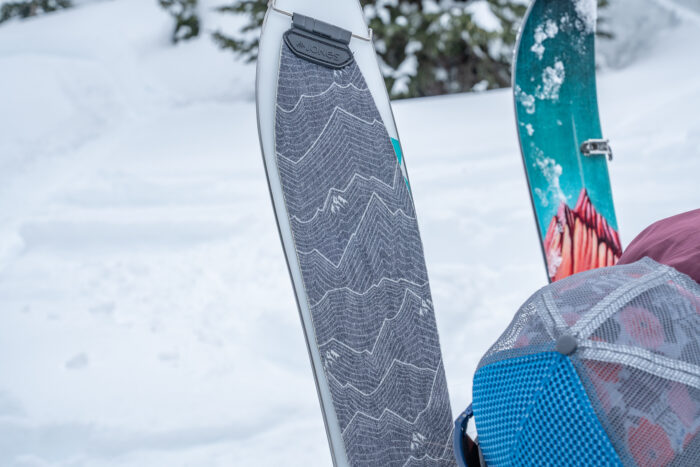
Drawbacks
Despite how giddy it made me to take sweeping turns with the 3D Contour Base, I noticed that the board has a tad less bite on steep, solid slopes compared to its predecessor. For big spring lines and vertical couloirs, I prefer a tiger’s jaw rather than a cat nibble. That said, I would still take this powerful splitboard over many others into consequential terrain.
Also, if you’re looking for a stiffer women’s splitboard — between a 7 and a 10 — they’re out there.
I don’t typically comment on topsheet graphics and palettes, but the Dream Weaver Splitboard and Twin Sister Snowboard are both vibrant, detailed, and beautiful in person. The older iteration of the Solution I had was a bright, bold turquoise. I love looking at all those boards! Why make this cover so dull and plain?
Lastly, the splitboard is a premium build at a top-shelf cost, so if you’re not prioritizing splitboarding and can’t bite the bullet, there are other steady builds that suit the majority of days in the backcountry and cost less.
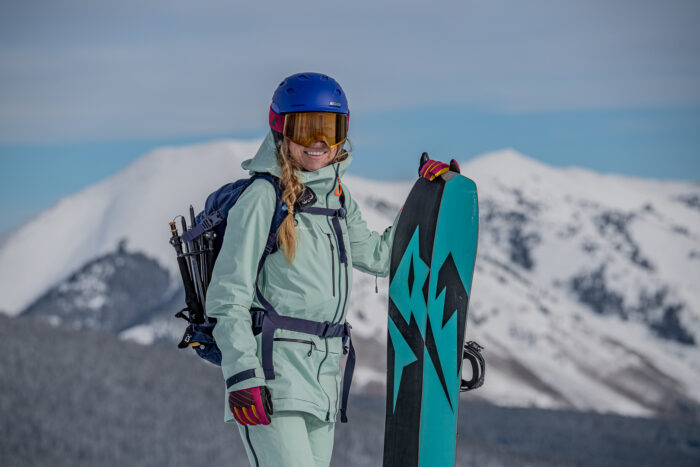
Jones Women’s Solution Splitboard: Conclusion
If you’re an invested rider spending many days in the backcountry bookend to bookend and across a variety of snow conditions, terrain, and in variable snowpack, consider the Jones Women’s Solution among your top contenders. The caveat being, if you prefer a splitboard on the stiffer-to-stiffest end of the spectrum, you might demo other rides that range in the 8-10 level of firmness — check out a Venture Oracle (stiffest) and Stranda Descender (stiffer).
For most days on snow, though, I found that the mid-to-upper-range flex, directional shape, and hybrid profile of the Women’s Solution was extremely stable, easy to steer edge-to-edge, and allowed me to ride aggressively when called. Plus, the spoon-shaped tip and tail, aka the 3D Contour Base, delivers woo-worthy flow.
As the technology continues to evolve, today’s Jones Women’s Solution remains one of the best-made splitboards for ladies on the market, hands down.
